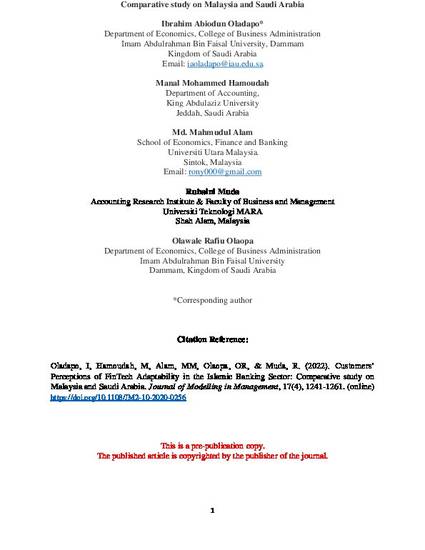
Article
Customers’ Perceptions of FinTech Adaptability in the Islamic Banking Sector: Comparative study on Malaysia and Saudi Arabia
Journal of Modelling in Management
(2022)
Abstract
Purpose – This paper aims to compare the perceptions of Islamic bank customers concerning FinTech services in Malaysia and Saudi Arabia. It also investigates the level to which customers are willing to adapt FinTech services.
Design/methodology/approach – Primary data were collected from May to September 2019 using a questionnaire to survey 102 Islamic bank customers in Malaysia, and 147 in Saudi Arabia.The data are analysed based on Structural Equation Modelling (SEM) using the partial least squares (PLS) approach.
Findings – The findings show that knowledge, attitude, and subjective norms are the highly significant determining factors that influence customers’ opinions on adapting to new technology, but awareness demonstrates only a moderately positive effect. Moreover, the impact of these factors on the intention to adopt FinTech services significantly differs between Malaysian and Saudi Arabian customers.
Originality/value – This is an original study based on primary data on customers of Islamic banking in Malaysia and Saudi Arabia. It provides some novel insights into how the Islamic banking industry can boost customers’ confidence and enhance their patronage by adopting FinTech in their business operation model. These findings should be of value to managers, policymakers, and regulators in the Islamic banking industry in both Muslim and non-Muslim countries.
Keywords
- Financial technology (Fintech),
- Islamic Bank,
- Attitude,
- Subjective norm,
- Knowledge,
- Malaysia,
- Saudi Arabia
Disciplines
Publication Date
2022
DOI
10.1108/JM2-10-2020-0256
Citation Information
Oladapo, I, Hamoudah, M, Alam, MM, Olaopa, OR, & Muda, R. (2022). Customers’ Perceptions of FinTech Adaptability in the Islamic Banking Sector: Comparative study on Malaysia and Saudi Arabia. Journal of Modelling in Management, 17(4), 1241-1261. (online) https://doi.org/10.1108/JM2-10-2020-0256
